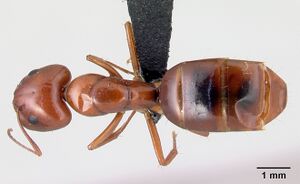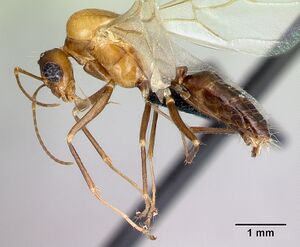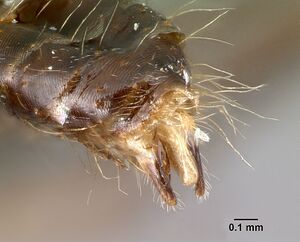Camponotus raina
| Camponotus raina | |
|---|---|

| |
| Scientific classification | |
| Kingdom: | Animalia |
| Phylum: | Arthropoda |
| Class: | Insecta |
| Order: | Hymenoptera |
| Family: | Formicidae |
| Subfamily: | Formicinae |
| Tribe: | Camponotini |
| Genus: | Camponotus |
| Subgenus: | Mayria |
| Species: | C. raina |
| Binomial name | |
| Camponotus raina Rakotonirina & Fisher, 2018 | |
This species is limited to the littoral and rainforests as well as the tropical dry forests of northeastern Madagascar. Members of C. raina have been found nesting in rotten logs and rotten sticks on the ground and foraging in leaf litter, on forest floors, and on low vegetation.
Identification
A member of the subgenus Mayria (see diagnosis). Rakotonirina and Fisher (2018) - Median portion of clypeus with longitudinal carina; anteromedian margin of clypeus covered with lamella; pronotum, junction of dorsum and declivity surface of propodeum and posterodorsal margin of petiole each with one pair of elongate, stout erect hairs; in lateral view, petiolar node longer than high; distal portion of procoxa white.
In the Camponotus subgenus Mayria, C. raina can be confused with Camponotus tanosy, but in the latter the anteromedian margin of the clypeus is not bordered by a lamella, the masticatory margin of the mandible is armed with five teeth, and the petiolar node is higher than long. Camponotus raina may also be confounded with Camponotus sada but the latter has an elongate but low mesosoma and a black to dark brown head and mesosoma.
Keys including this Species
Distribution
Latitudinal Distribution Pattern
Latitudinal Range: -12.97° to -13.71533°.
| North Temperate |
North Subtropical |
Tropical | South Subtropical |
South Temperate |
- Source: AntMaps
Distribution based on Regional Taxon Lists
Malagasy Region: Madagascar (type locality).
Distribution based on AntMaps
Distribution based on AntWeb specimens
Check data from AntWeb
Countries Occupied
| Number of countries occupied by this species based on AntWiki Regional Taxon Lists. In general, fewer countries occupied indicates a narrower range, while more countries indicates a more widespread species. |

|
Estimated Abundance
| Relative abundance based on number of AntMaps records per species (this species within the purple bar). Fewer records (to the left) indicates a less abundant/encountered species while more records (to the right) indicates more abundant/encountered species. |

|
Biology
Castes
Worker
Images from AntWeb
   
| |
| Paratype of Camponotus raina. Worker (major/soldier). Specimen code casent0499052. Photographer Erin Prado, uploaded by California Academy of Sciences. | Owned by CAS, San Francisco, CA, USA. |
Queen
Images from AntWeb
    
| |
| Queen (alate/dealate). Specimen code casent0498581. Photographer Erin Prado, uploaded by California Academy of Sciences. | Owned by CAS, San Francisco, CA, USA. |
Male
Images from AntWeb
     
| |
| Male (alate). Specimen code casent0076653. Photographer Erin Prado, uploaded by California Academy of Sciences. | Owned by CAS, San Francisco, CA, USA. |
Nomenclature
The following information is derived from Barry Bolton's Online Catalogue of the Ants of the World.
- raina. Camponotus raina Rakotonirina & Fisher, 2018: 47, figs. 5B, 6A, 31, 39 (s.w.) MADAGASCAR.
- Combination in C. (Mayria): Rakotonirina & Fisher, 2018: 47.
Unless otherwise noted the text for the remainder of this section is reported from the publication that includes the original description.
Description
Worker
Minor. In full-face view, head longer than wide, lateral margin straight and slightly converging posteriorly; posterior margin more or less straight. Anteromedian clypeal margin broadly convex and with broadly rounded, translucent lamella. Eyes breaking lateral outlines of head, their posterior margins located well behind the mid-length of the head (PoOc/CL: 0.35±0.02; 0.31–0.37). Mandible triangular, apical margin with six sharp teeth. Antennal scape long, roughly its distal half extending beyond posterior cephalic margin. In lateral view, promesonotum flat and becoming curved toward junction to propodeum; propodeal dorsum straight, propodeal declivity inclined posteriorly; petiolar node longer than high.
Blunt, elongate, erect brown hairs and short and sparse pubescence present on dorsum of head, petiolar node, and gastral segments. Head reddish-orange laterally and reddish-black to dark brown frontally, petiole reddish-black to dark brown; trochanter and distal portion of coxae whitish-yellow; abdominal segments yellow-orange with black patches in anterolateral portions of 3 and 4 and darker color from segment 6; scape, femur, and tarsus a lighter color.
Major. With characterisitics of minor worker, except for the following divergent features: enlarged head, apical fifth of antennal scape surpassing posterior cephalic margin, much more robust mesosoma, pronotum and mesonotum forming a convexity, separated from propodeum by a distinct metanotum; propodeal dorsum rounding to declivity; petiolar node tapering dorsally; larger dark brown to black spots on gastral tergites, sometimes on mesosoma and head.
Type Material
Holotype worker. Madagascar: Province Antsiranana, Forêt d'Andavakoera, 21.4 km 75° ENE Ambilobe; 4.6 km 356° N Betsiaka, -13.11833, 49.23, 425 m, ex rotten log, rainforest 16 Dec 2003 (B.L. Fisher et al.) BLF10292, CASENT0499051 (California Academy of Sciences).
Paratypes. 8 minor and 6 major workers with same data as holotype but with specimen codes: minors: CASENT0499049, CASENT0499050, CASENT0804659, CASENT0804660, CASENT0804661, CASENT0804662, CASENT0804663, CASENT0804664; majors: CASENT0499052, CASENT0499053, CASENT0804665, CASENT0804666, CASENT0804667, CASENT0804668 (CASC, The Natural History Museum, Musee d'Histoire Naturelle Genève, Museo Civico di Storia Naturale, Genoa, Parc Botanique et Zoologique de Tsimbazaza).

